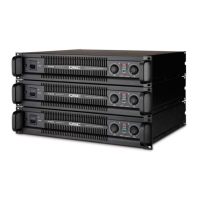PL3 Series Service Manual 21
TD-000274-00 Rev. A
Figure 2.1. Signal with 250 kHz
switching noise
Figure 2.2. Signal with switching noise
filtered out
Figure 2.3. Burst sine wave signal for
2
Ω
power testing
Test Equipment required:
• Distortion analyzer with built-in signal generator
The generator must have total harmonic distortion plus noise
(THD+N) of no higher than 0.01%, and the analyzer must be
capable of resolving to that level as well. We suggest either the
HP-Agilent 339A
or the
Audio Precision System One, System
Two, ATS-1,
or
ATS-2
. The PL380 test procedures written for
Audio Precision System One can be obtained by sending an e-
mail request to tech_support@qscaudio.com.
• High power load resistor bank (8, 4, and 2 ohms)
• 20 MHz oscilloscope and digital multimeter
• Switching amplifier measurement filter
Suggested:
Audio Precision AUX-0025)
• Variable autoformer (Variac, Powerstat, etc.), 0–140 V AC,
50 A for 100 V/120 V models or 0–260 V AC, 30 A for 230 V
model
• Burst sinewave generator (if the analyzer doesn’t have burst
output mode)
Suggested:
HP 33120A Waveform Generator
Notes:
• The PL380 is a class D amplifier; as such, it uses a process that
results in some residual 250 kHz switching noise in the amplifier
output signal; this noise could produce misleading results in
measurement of power, percent THD, and noise. We recommend
using a low-pass filter such as the Audio Precision AUX-0025 to
reduce the noise prior to the analyzer. Figures 2.1 and 2.2 show
the PL380 amplifier’s output signals with and without the AUX-
0025 filter.
• Measuring 2-ohm power requires a burst sine wave signal
(Figure 2.3). This is to avoid excessive power supply current
demand under testing, which would trigger the protection circuit
and quickly reduce the output power to a safe level (approxi-
mately 2800 watts with a continuous sine wave signal).
The circuit design of the PL380 is fine-tuned and requires no internal
trim pots. Therefore, no adjustment or calibration is required during
testing. If the amplifier does not meet specifications in this test
procedure, it requires service. Follow the troubleshooting guide in
the service manual to repair the amplifier as needed.
Setup
1. Set switches and controls as follows:
• AC switch (front panel)
off
.
• Gain controls (front panel) to minimum, or fully counter
clockwise.
• Mode switch (rear panel) on
stereo
.
• Sensitivity switch (rear panel) on
32 dB
.
• Clip limiter switches (rear panel)
off
.
• High-pass filter switches (rear panel)
off
.
2. Connect a test load(s) to the output terminals of the amplifier.
3. Connect the distortion analyzer input to the AP AUX-0025 filter’s
channel A output.
4. Connect the AP AUX-0025 filter’s channel A input to the channel
1 output terminals of the amplifier.
5. Set up and connect a dual-channel oscilloscope to the following
test points:
• Channel 1—Set vertical sensitivity to 2 V/div; connect a
10× probe to the channel speaker output.
• Channel 2—Set vertical sensitivity to 0.1 V/div; connect a
1× scope probe to the distortion analyzer output.
6. Connect the analyzer’s test signal output to the amplifier’s
channel 1 XLR input.
7. Set the analyzer signal to a 1.0 V rms 1 kHz sine wave.
8. Turn on the analyzer’s 80 kHz filter.
2.3 PL380 Test Procedure

